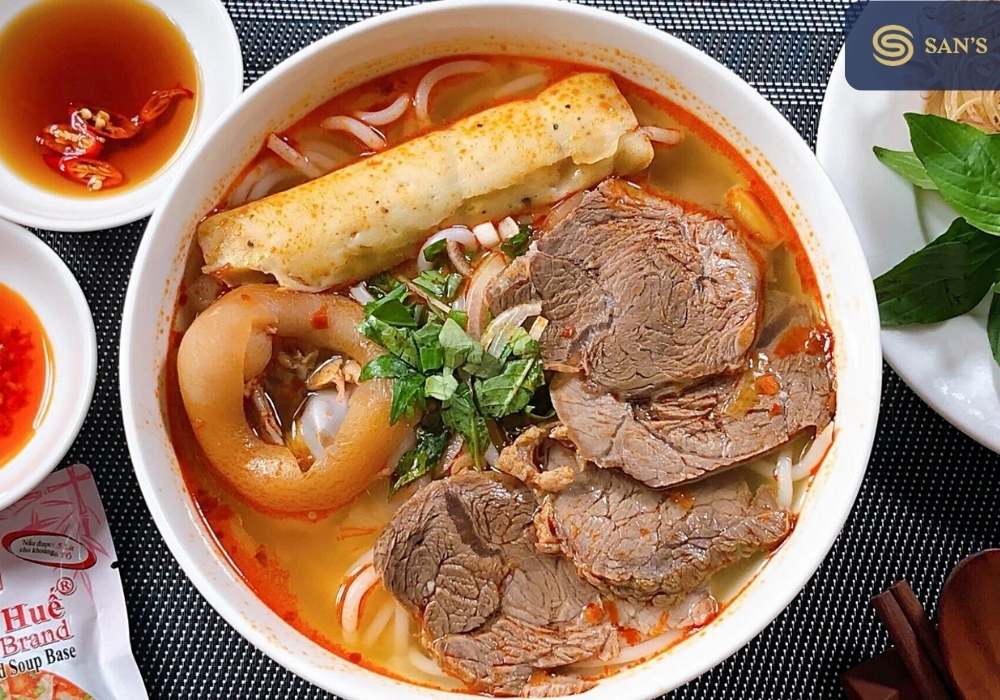The allure of Bun Bo Hue goes beyond its tantalizing spice; it’s a harmonious blend of contrasting flavors that exemplify the Vietnamese culinary philosophy. The dish’s history is as colorful as its presentation, stemming from royal beginnings to becoming a staple that delights food enthusiasts globally. In this guide, you’ll embark on a flavorful expedition how to make Bun Bo Hue, unraveling the secrets behind its simmering broth and learning the intricacies of its assembly.
Whether you’re a passionate home cook or an adventurous eater, the journey of how to make Bun Bo Hue will inspire and challenge you to bring a taste of Vietnam right into your kitchen.

What is Bun Bo Hue?
Bun Bo Hue is a symphony of taste, a noodle soup that is both vibrant and soul-soothing, featuring a medley of ingredients that create a tapestry of flavors in every bowl. It’s built upon a foundation of rice vermicelli noodles and a stock that’s deeply infused with the essence of beef and pork bones, simmered to perfection with a bouquet of spices like lemongrass, annatto, and shrimp paste.
This creates a broth that’s rich, hearty, and unmistakably spicy, distinguishing Bun Bo Hue from its more globally known cousin, Pho.
The true magic of Bun Bo Hue lies in its toppings: slices of tender beef shank, chunks of oxtail, and sometimes even congealed pig blood, which add layers of texture and flavor. A colorful garnish of lime wedges, cilantro, diced green onions, banana blossoms, and mung bean sprouts crowns the dish, inviting diners to customize their bowl to their taste.
To understand how to make Bun Bo Hue is to understand the balance of savory, spicy, sweet, and umami flavors that make up Vietnamese cuisine. It’s this balance that sets Bun Bo Hue apart, offering a culinary adventure that’s robust and refined, all in one spoonful.
The Ingredients You’ll Need
Embarking on the journey of how to make Bun Bo Hue at home starts with gathering the right ingredients. This list will guide you through the essential components needed to capture the authentic taste of this storied Vietnamese soup.

- Broth Base:
- Beef bones – 2-3 pounds for a rich stock
- Pork knuckles or trotters – for depth and gelatinous body
- Lemongrass stalks – bruised and tied, to infuse the broth with citrusy notes
- Shrimp paste – a spoonful for umami depth
- Annatto seeds or powder – for the soup’s signature reddish hue
- Protein:
- Beef shank – thinly sliced, for tender bites
- Oxtail pieces – optional, but recommended for richness
- Pork hock – adds traditional flavor and texture
- Blood cubes – optional, for the adventurous willing to adhere to tradition
- Aromatics and Spices:
- Onion and garlic – charred for smoky sweetness
- Ginger – charred for a warm, spicy note
- Star anise, cloves, and cinnamon stick – the spice trio that gives complexity
- Noodles:
- Rice vermicelli noodles (Bun) – the thicker variety, specific to Bun Bo Hue
- Accompaniments:
- Fresh herbs – cilantro, Thai basil, and mint
- Bean sprouts – for crunch
- Lime wedges – for a hit of acidity
- Banana blossom – thinly sliced, for a floral, crunchy addition
- Red cabbage – a substitute for banana blossom if unavailable
- Jalapeños or bird’s eye chilies – for extra heat
- Substitutes for Non-Vietnamese Locales:
- Lemon zest and bay leaves can be used if lemongrass is not available.
- Paprika mixed with a touch of turmeric can replace annatto for color.
- If shrimp paste is too elusive, a combination of fish sauce and a small amount of miso can mimic its role.
- In lieu of blood cubes, firm tofu cut into cubes can provide a similar visual and textural component.
With these ingredients at hand, you’re ready to dive into how to make Bun Bo Hue, bringing the warmth and spirit of Vietnamese cooking into your own kitchen.
Preparing the Broth: The Heart of Bun Bo Hue

The soul of any Bun Bo Hue lies in its broth, a mesmerizing blend of beefy richness and aromatic spices. Follow these step-by-step instructions on how to make Bun Bo Hue broth to achieve that signature depth and complexity.
- Initial Preparation:
- Begin by thoroughly rinsing your beef and pork bones under cold water to remove any impurities.
- In a large pot, cover the bones with cold water, bring to a boil, and then let them blanch for about 10 minutes. This process helps achieve a cleaner broth.
- Creating a Flavor Base:
- While the bones blanch, char your onions, garlic, and ginger either over an open flame or in a broiler until they develop a slight blackened exterior. This charring will impart a smoky depth to the broth.
- Spice Infusion:
- Tie your bruised lemongrass, star anise, cloves, and cinnamon stick in a cheesecloth bundle. This spice bouquet will infuse the broth without leaving residue behind.
- Cooking the Broth:
- After blanching, drain and rinse the bones again, then return them to the pot with fresh water.
- Add your charred aromatics and spice bundle to the pot, alongside the shrimp paste and annatto seeds for color and umami.
- Bring the mixture to a gentle boil, then reduce the heat to a simmer.
- Simmering Techniques:
- The key to a clear and flavorful broth is a long, slow simmer. Aim for at least 3-4 hours on a low heat, allowing the flavors to meld together.
- As the broth simmers, skim off any impurities or foam that rise to the surface. This skimming is crucial for achieving a clear broth and is best done with a fine mesh strainer.
- Seasoning the Broth:
- After several hours of simmering, season the broth with fish sauce and fine-tune with salt and sugar to balance the savory and sweet notes.
- A properly seasoned broth should have a bold beef flavor with a hint of sweetness and a pronounced aroma from the spices.
- Final Strain:
- Once the broth has achieved the desired flavor and clarity, remove it from the heat.
- Strain the broth through a fine-mesh sieve or cheesecloth to remove any remaining solids. You should be left with a clear, amber-colored liquid that’s rich in flavor.
- Serving Suggestions:
- To serve, reheat your broth until it’s piping hot and ready to pour over prepared bowls filled with rice noodles and your choice of meats.
Understanding how to make Bun Bo Hue broth is about patience and attention to detail. The care you put into each step—from simmering to skimming—will be evident in every savory spoonful, encapsulating the very essence of this beloved Vietnamese dish.
Selecting the Right Meat and Noodles

To master how to make Bun Bo Hue, selecting the appropriate cuts of beef and the perfect type of rice noodles is paramount. Opt for beef shank, which offers a balance of lean meat and connective tissue that tenderizes beautifully when simmered, imparting a rich flavor to the broth.
Beef oxtail or brisket can also be incorporated for additional body. When it comes to noodles, seek out the round and thicker Bun Bo Hue noodles, which are heftier than those used in Pho, to stand up to the robust soup.
Prior to cooking, marinate the beef in a mixture of shrimp paste, fish sauce, sugar, and a touch of salt, allowing the flavors to permeate the meat. Cooking times will vary; the beef shank should be simmered until tender, often taking up to 1.5-2 hours, while other meats like brisket may require a longer cooking time to achieve the desired tenderness.
The Toppings and Garnishes
An authentic bowl of Bun Bo Hue is adorned with an array of toppings and garnishes that add texture and elevate the flavor. Traditional toppings include thinly sliced beef shank, tender pig’s knuckles, and occasionally, congealed blood cubes, known for their unique texture and ability to absorb the flavors of the broth.
Fresh garnishes are essential in how to make Bun Bo Hue complete. Prepare a plate of chopped cilantro, sliced green onions, fresh Thai basil leaves, and mint for guests to add as they please. Lime wedges should be squeezed over the bowl to introduce a bright acidity, while thinly sliced chilies can be added for an extra kick of heat.
These garnishes not only provide a fresh contrast but also allow each individual to tailor the dish to their taste, making the experience of Bun Bo Hue both personal and communal.
FAQs about how to make Bun Bo Hue:
- What are the key ingredients in Bun Bo Hue?
- “The key ingredients for how to make Bun Bo Hue include beef bones, lemongrass, shrimp paste, annatto seeds, beef shank, pig’s knuckles, rice vermicelli noodles, and a variety of fresh herbs and vegetables for garnish.”
- Can I make Bun Bo Hue without beef or pork?
- “While traditional Bun Bo Hue includes beef and pork, you can substitute with chicken or go meatless using mushrooms and tofu to cater to dietary preferences.”
- How do I achieve the distinct color of Bun Bo Hue?
- “The reddish hue comes from annatto seeds, which are fried in oil to release their color before being added to the broth. Paprika can be used as a substitute if annatto seeds are unavailable.”
- What makes Bun Bo Hue spicy, and how can I adjust the heat level?
- “The heat in Bun Bo Hue comes from the addition of chilies and chili oil. You can control the spiciness by adjusting the amount of chili used or serving it on the side for individual preference.”
- Is there a vegetarian version of Bun Bo Hue?
- “Yes, you can create a vegetarian version by using vegetable stock and replacing the meat with tofu and mushrooms. Fish sauce can be substituted with soy sauce or vegan fish sauce.”
- What if I can’t find all the traditional toppings?
- “While traditional toppings add to the authenticity, the dish can still be enjoyable with the toppings you have available, as long as you maintain the integrity of the broth.”
- How long does it take to cook Bun Bo Hue?
- “How to make Bun Bo Hue involves simmering the broth for several hours to develop a deep flavor, so it’s best to set aside at least half a day for cooking, or consider making the broth a day ahead.”
- Can I make Bun Bo Hue in a slow cooker?
- “Yes, a slow cooker can be used to simmer the broth. It’s an excellent way to develop flavors over a longer cooking time with less active supervision.”
- How do I store leftover Bun Bo Hue?
- “Leftover Bun Bo Hue can be stored in the refrigerator for up to three days. Store the broth separately from the noodles and toppings to keep everything fresh.”
- Can Bun Bo Hue be frozen?
- “The broth for Bun Bo Hue can be frozen for future use. However, it’s best to add fresh noodles and toppings when you’re ready to serve.”
- What is the best way to serve Bun Bo Hue to guests?
- “Serve Bun Bo Hue in large bowls, allowing guests to add their own herbs, garnishes, and additional spice to taste. It’s a communal dish that everyone can customize at the table.”





